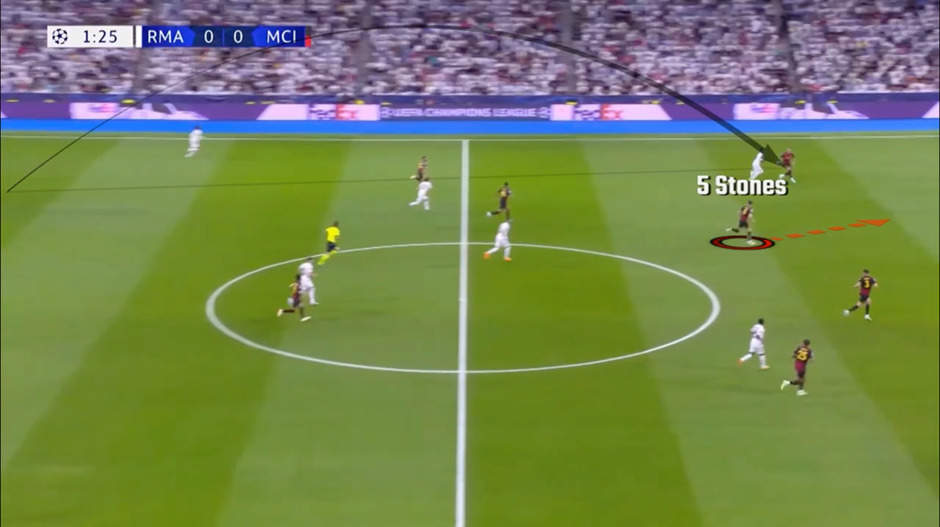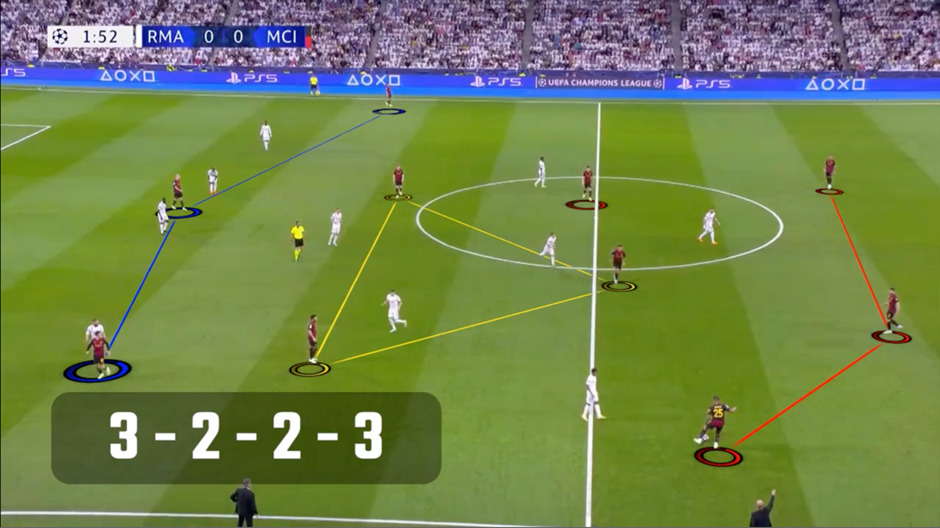Table of Contents
The need for changes
How John Stones new role has helped Manchester City to be so dominant this season and the main contender for the premier league title. The departure from Manchester City’s squad of some important players for Pep Guardiola’s Game Model forced the Catalan coach to search for other solutions. Pep’s philosophy requires his team to always overload the center of the pitch either to play through the center or to force the opponents to have narrower positions that create spaces to the flanks for a 1 v 1 situation.
His favorite structure of 3 – 2 – 2 – 3 during the attacking phase could not be accomplished with Walker, Nathan Ake, or Akanji as Full Backs. The concept of inverted full-backs that he successfully managed to present during the last 2 years was not feasible due to his current full-backs’ individual characteristics.
So, the solution he presented to the football world is the “false center back”.
After the “false 9” and the “inverted full-backs” now it’s time for a center back to have a more mobile and flexible position on the pitch. The term “false center back” is very important because it shows the initial position of the player on the pitch and Guardiola’s tactical intentions. It’s not a midfielder who becomes a center-back when needed but it’s a center-back who pushes forward in the midfield to create numerical overload and more passing options but at the same time a defensive balance in case of loss of ball control.
The player who is more capable to accomplish this heavily tactical behavior is no one else than John Stones.
In this article, we will analyze how Stones has adapted to his new role, how he manages to execute it and what benefits it brings to his team.
John Stones new role – The “false center back”, Guardiola’s concept in world football
Stones is widely regarded as one of the best ball-playing center-backs in the world, with his ability to pass, dribble and intercept the ball. However, in recent weeks, Stones has been deployed in a different role by his manager Pep Guardiola. Instead of playing as a normal center-back, John Stones new role is to switch from center-back to defensive midfielder depending on the game’s current situation and based on the teammates, oppositions, and ball position on the pitch.
One of the reasons why John Stones can excel in his new role is his high technical quality. He is comfortable on the ball and can distribute it accurately and quickly. He can also dribble past opponents and create space for himself and his teammates. He is not afraid to take risks and play forward passes that can break the opposition’s lines. He has also improved his defensive skills, such as tackling, intercepting, and positioning.
Stones has been one of the most impressive players in the Premier League this season. The Manchester City defender has shown his versatility and adaptability by playing in different positions on the pitch from match to match. He is used as a Central Defender, As a Right Back, and as a Defensive Midfielder. But the most impressive innovation that we have witnessed this year is John Stones new role as a “false” center back.
In the season 2022 – 2023, he has an amazing 94.4% passing accuracy. Against Real Madrid, he had a position higher up the pitch which helped his team to maintain high levels of possession, especially in the 1st half, in the opponent’s half. The 0 long passes showed his passing actions behavior on the specific day.
The new role requires Stones to have attacking and defensive awareness, tactical discipline, and physicality. He must think at the same time about how to be available for his teammates to offer support in the attacking phase but at the same time must keep in mind what to do in case of losing ball control.
Stone’s physical attributes make him ideal for this role. He is tall, strong, and fast, which gives him an advantage in duels and aerial battles. He can also cover a lot of ground and support the attack or the defense depending on the situation.
By playing in different positions, Stones can benefit his team to be more formation-flexible during the matches and more unpredictable. He is an intelligent player who can adjust to different formations, systems, and opponents which gives him opportunities to influence the game even more.
Train like Pep Guardiola using Positional Games, Rondos, Possession Games and Passing Drills direct from his coaching philosophy!
PEP GUARDIOLA – 85 PASSING, RONDOS, POSSESSION GAMES & TECHNICAL CIRCUITS DIRECT FROM PEP’S TRAINING SESSIONS

Looking to take your team’s performance to the next level?
- Warm-ups (training and match day)
- Speed & Agility (without/with ball)
- Technical Circuits
- Passing
- Rondos
- Juego de Posición (Positional Games)
- Possession Games
- Attacking Positional Patterns of Play
- Small to Large Sided Games
- Taken directly from Pep’s training sessions at Manchester City, Bayern Munich and FC Barcelona.
- This is your chance to practice and apply Pep Guardiola’s training sessions to develop your players’ speed, agility, technique and positional play – a unique opportunity to improve your team’s performance using practices from the highest level.
Stone’s tactical analysis against Real Madrid
Let’s take the 1st leg of the UEFA Champions League semi-final of Manchester City FC match against Real Madrid to analyze Stone’s tactical behavior during the different game phases. Below are the lineups of the two teams. Manchester City’s formation.

Man City started the game with a 4 – 4 -2 which during the attack was transformed to a 4 – 3 – 3 in the build-up or 3 – 2 – 2 – 3 higher up the pitch. The back 4 were Manuel Akanji, Ruben Dias, John Stones, and Kyle Walker. The two midfielders were Rodri and Gundogan with Jack Grealish and Bernardo Silva occupying the two Winger’s positions. Up front, Erling Haaland is a center forward and De Bruyne is in a fluid role.
Against Real M. Stones had a huge involvement in the attacking phase. As shown in the below diagram, the average position of Stone during the game was the same as the defensive midfielder Rodri, much higher than the other center-back, Dias.

Defensive phase
During the defensive phase, John Stones acted like a normal center back in a back-four formation. He usually plays as a right center back with Ruben Dias to the left.

Stones fulfilled all the fundamentals of a back 4 defensive line. He kept the line to avoid any chances for Madrid’s players to break the offside. He always tried to read the situation and act accordingly. Whenever was necessary he jumped forward to press any player between the lines either an attacking midfielder or a center forward who drops back.

When Manchester City was forced to defend in a low block, Stones covered the central area of the box to defend the crosses or block shoots outside the box.

In case the team was in a higher position and they were not able to recover the ball, Stones was capable to provide defensive cover in case of long balls to the space behind the defensive line.

Stone’s initial position higher up the pitch during the attacking phase turns him into a key player in rest defense. He could press faster and in a more efficient way than any player near the ball and deny any efforts from Real M. to get out of pressure.


In cases where an immediate press to recover the ball was not feasible, and the opponents manage to switch sides he returned to his initial position as a center back to create the back 4 line.


Attacking phase
Pep Guardiola showed from his first coaching period in Barcelona his love for overloading the central area. During the years what changed was the way his team managed to accomplish it and what were the benefits from this tactical concept.
During the period he coached the Blaugranas, the central overload was accomplished mainly by Messi acting as a false 9, dropping from a center forward position between the lines. The formation was transformed from a 4 -3 – 3 to a 4 – 4 – 2 diamond or a 3 – 4 – 3 with Dani Alves pushing up on the right side and Pedro getting inside. During his time in Germany and Bayern Munich, he tried to create these overloads with Lam acting as an inverted full-back. This concept he also implemented it in Manchester City with Cancelo and Zinchenko, two very quality and tactically intelligent players.
Now that the two full-backs are out of Etihad Stadium, the responsibility for overloading the central area in the last games is on John Stones. Starting with a 4 – 4 – 2 or 4 – 3 – 3 formation which changes to a 3 – 2 – 2 – 3 in the attacking phase, Stone has the freedom to switch position from center back to defensive midfielder when specific requirements are in place.

Let’s take the 1st leg of the Champions League semi-final match against the Spanish as an example to analyze Stone’s tactical behavior during the different game phases.
The position of John Stones in the center of the pitch provided some benefits for Man City regarding the balanced special occupation on the pitch. By having two pivots, the defensive line had more passing opportunities to move the ball forward. Also, Ilkay Gundogan had the flexibility to move higher up the pitch occupying one of Guardiola’s favorite spaces, the half-spaces.
At the same time, by having the center of the pitch overloaded, the two wingers could keep wider positions that resulted in stretching Madrid’s defensive line and creating gaps for penetration runs or passes. In cases where Real kept a narrower defensive block to protect the central area, that created opportunities for Grealish and Silva to receive the ball in wide areas and go for 1 v 1 situation.

Build up
During the build-up, Stones had the usual position of a center back. He offered support to Ederson for a short pass and at the same time he allowed Walker to have a higher position on the pitch for Ederson to have a 2nd line passing option.
One of the most important parameters in Guardiola’s game is for his team to break the 1st line of pressure with minimum risk of losing the ball. Thus, the creation of numerical superiority at the back with a back 4 against Madrid high pressure was necessary.


Progression Zone
When Manchester City managed successfully to overcome the 1st line of pressure and move up to the next zone, the middle third or “progression zone”, it was the time when Stone had the opportunity to join the center. Of course, to do that, two very specific requirements were mandatory for John Stones new role to be implemented successfully on the field.
First, for Stone to push up in the center it was necessary for Walker to have a deep position. That would allow City to create a back three which helped them to circulate the ball in a more controlled way. In cases where the right full-back was forced to occupy a higher position on the pitch to offer support or to make an attacking action (overlap or underlap), then Stones kept a deep position providing the necessary balance.
The second and very important requirement was for the ball to be or to travel towards the other side and City to have the ball under control. It’s the same principle that Cancelo followed when he was playing as an inverted full-back. The timing when Stone was pushing up in the center is critical. Pushing too early without having a safe ball possession can cause dangerous situations by creating gaps in the center of the defensive line that the opponents can take advantage of fast counter-attack.
When the ball was on the left side, Real Madrid’s players shifted to keep their defensive compactness and their focus was to press that side. Thus, Stone had the time and space to move forward in the center in the opponent’s blind spot.



Stones and Rodri have a good tactical understanding between them, the so-called socio-affective superiority one of Positional Play 4 types of superiority, that allowed them to easily rotate positions and made it very difficult for Madrid’s player to avoid passes toward the center of the pitch.

Final Third
Against Real M., Stones had 6 progressive runs in the game while De Bruyne had 3 and Gundongan had only 1. That shows the impact of Stone’s movement without the ball with forward runs that offered passing options in advanced areas and at the same time dragged opponents out of position which created spaces for other teammates.
Stones usually made his runs in the right half-space whenever he spotted a gap in Real Madrid’s defensive line. His runs were done either after a pass-and-go movement or when the ball was out wide with forward runs in the box.


Conclusion:
In conclusion, John Stones new role has been a revelation this season by playing in different positions on the pitch but mainly by playing the role of “false center back”. He has shown his technical, physical, and tactical qualities, as well as his versatility and adaptability. He has become a key player for Manchester City and he has confirmed that he is one of the best defenders in the world able to influence a match in all 4 phases of the game.

